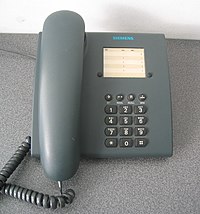Landline
This article needs additional citations for verification. (January 2008) |


A landline telephone (also known as land line, land-line, main line, homephone, landline, fixed-line, and wireline) refers to a phone which uses a solid medium telephone line such as a metal wire or fiber optic cable for transmission as distinguished from a mobile cellular line which uses radio waves for transmission.
In 2003, the CIA reported approximately 1.263 billion main telephone lines worldwide. China had more than any other country at 350 million and the United States was second with 268 million. The United Kingdom has 23.7 million residential fixed landlines.[1] In 2008, the world had 1.27 billion fixed line subscribers.[2]
Fixed phone
A fixed phone line (a line that is not a mobile phone line) can be hard-wired or cordless.
Fixed wireless refers to the operation of wireless devices or systems in fixed locations such as homes. Fixed wireless devices usually derive their electrical power from the utility mains electricity, unlike mobile wireless or portable wireless which tend to be battery-powered. Although mobile and portable systems can be used in fixed locations, efficiency and bandwidth are compromised compared with fixed systems. Mobile or portable, battery-powered wireless systems can be used as emergency backups for fixed systems in case of a power blackout or natural disaster.
Dedicated lines
The term landline is also used to describe a connection between two or more points that consists of a dedicated physical cable, as opposed to an always-available private link that is actually implemented as a circuit in a wired switched system (usually the public switched telephone network). So-called leased lines are invariably of the latter type; the implications of a land line in this context are security and survivability. For example, a military headquarters might be linked to front-line units "by landline" to ensure that communication remains possible even if the conventional telephone network is damaged or destroyed. Another example of this is in airports. All air traffic control towers have dedicated lines connected to the police, fire department, hospitals, army, etc. Deployed as a precaution in case of emergency, these can be used at any time.
Decline of the Landline Phone
In recent years, the landline telephone has seen major decline due to the advancement of mobile network technology and the obsolescence of the old copper wire networking. In the coming years, the use of these networks will be deemed completely out of date and replaced with the use of more efficient broadband and fiber optic connection extending to rural areas and places where telecommunication was much more sparse. Some see this happening as soon as the year 2025[3] .
In 2004, only about 45% of people between the ages of 12 and 17 owned cell phones. As a means of communication in that time, they had to rely on the use of landline telephones. in just 4 years time, that percentage reached a total of about 71%. That same year, 2008, about 77% of adults owned a mobile phone. In the year 2013, 91% of adults own a mobile phone. Of that 91%, almost 60% have a smart phone. Because of these demographics, over the course of 9 years, the likelihood of not only a teenager, but an adult using a landline phone have decreased greatly. Some households may not even have a landline phone at all, while others have one as a fail-safe line in case of emergencies or as a receiver for otherwise unwanted calls.
The landline may not be extinct as a form of technology, but it's heyday has passed as a primary source of telecommunication.
See also
References
- ^ http://www.homephonechoices.co.uk/landline.html
- ^ Measuring the Information Society: The ICT Development Index (PDF). International Telecommunication Union. 2009. p. 108. ISBN 92-61-12831-9.
- ^ Cite error: The named reference
undefinedwas invoked but never defined (see the help page).
